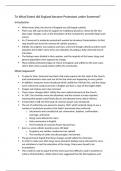To What Extent did England become Protestant under Somerset?
Introduction
When Henry died, the church of England was still largely catholic.
There was still a great deal of support for traditional practices, shown by the fact
that major changes, such as the dissolution of the monasteries, provoked large-scale
unrest.
So, if Somerset (a moderate protestant) wanted to introduce Protestantism, his first
step would have to be the removal of catholic practices.
Initially, his progress was cautious and slow, and even though catholic practices were
attacked, there didn’t seem to be any indication of putting a fully reformed church
into place.
The bishops were divided in their opinion, and the majority of the lower clergy and
general population were opposed to change.
Many exiled protestants began to return to England, and settled on the east coast,
where their views caused clashes within the community.
What Happened?
To play for time, Somerset launched a full-scale enquiry into the state of the church,
and commissioners were sent out to find out what was happening in every parish.
In addition, measures were introduced which undid the 6 Articles Act, and the clergy
were ordered to conduct services in English and have a copy of the English bible.
Images and statues were also removed.
These minor changes didn’t satisfy the more radical elements of the church.
In 1547, the chantries were also dissolved, and the treason act was repealed,
meaning that people could freely discuss and demand more radical reforms.
In December 1548, the first book of common prayer was introduced.
The act of uniformity was passed in January 1549, which ordered clergy to use a
number of protestant practices that hadn’t previously been enforced:
o Sacraments now consisted of just communion, baptism, confirmation,
marriage, and burial.
o Clergy were allowed to marry.
o Holy communion in English.
o The First Book of Common Prayer became law.
Even so, some catholic practices were still kept:
o Purgatory was neither condemned nor upheld.
o The worship of saints was discouraged, not banned.
The government hoped that these changes would satisfy the reformers.
In order to make sure that clergy were educated, bishops were instructed to carry
out visitations to test the education of the clergy. Many were found to be
incompetent.
This could be used to argue that this shows just how difficult a task it would be to
enforce Protestantism, whilst others have suggested that the thoroughness and
, efficiency of such investigations shows that the church was willing to take action to
enforce the new changes.
However, there was still some resistance, which came to light in the summer of
1549, which eventually led to Somerset’s downfall.
By the time of Somerset’s fall, most catholic practices had been attacked, and many
had been destroyed, yet moves to implement a protestant faith had proceeded
slowly and had been met with resistance.
How Radical were Religious Changes under Northumberland?
Although it might be expected that the unrest in 1549 would caution the
government against protestant reforms, this was far from the case.
Despite the catholic rising being put down, and the threat from the general
population quelled for the time being, it must be remembered that there was still
factional struggle withing the government itself.
Additionally, although the government was keen to impose these changes, there was
a large amount of both confusion and opposition amongst the clergy and peasants.
This is illustrated by the fact that it took multiple attempts over several years to
enforce the ban on images:
o July 1547 – royal injunctions ordered the removal of images.
o February 1548 – all images to be removed.
o December 1549 – proclamation orders the destruction of the remainder of
the images.
However, Northumberland strengthened his grip on power in 1551, and this allowed
further religious changes to take place.
Many reformists were deprived of their sees (jurisdictional rights), which gave the
reformists a majority among the bishops.
Therefore, in January 1552, the new treason act was introduced which made it an
offence to question the royal supremacy or any beliefs of the church.
In March the same year, the second act of uniformity was introduced.
However, the most notable move towards Protestantism came with the second
prayer book, which became the basis for church services and had to be used.
To what Extent was England a Protestant Country by Edward’s
Death?
Introduction
There seemed to be slow and steady moves towards Protestantism at the start, and
then in the last few months major protestant reforms were made, with the second
prayer book and act of uniformity, along with the 42-articles.
Moreover, these would have had very little time to have a lasting impact on the
beliefs of the population.
Even so, protestant influence in the council, in the bishopric, and the clergy had
increased.




